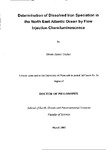Determination of Dissolved Iron Speciation in the North East Atlantic Ocean by Flow Injection Chemiluminescence
| dc.contributor.author | Ussher, Simon James | |
| dc.contributor.other | Faculty of Science and Engineering | en_US |
| dc.date.accessioned | 2013-10-10T09:23:09Z | |
| dc.date.available | 2013-10-10T09:23:09Z | |
| dc.date.issued | 2005 | |
| dc.identifier | NOT AVAILABLE | en_US |
| dc.identifier.uri | http://hdl.handle.net/10026.1/2140 | |
| dc.description.abstract |
The knowledge of iron biogeochemistry is constrained by paucity in the understanding of its uptake, transport and the partitioning of the element between different phases, redox states and coordination sites. The work presented in this thesis describes the optimisation and evaluation of a Flow Injection Chemiluminescence (FICL) method for the shipboard determination of dissolved Fe(II) species (< 0.2 µm) in seawater. This includes results from two ship-board trials and a study of the effects of model ligands on iron redox speciation measurements in natural waters. The method was also used to determine the distribution of dissolved iron species (< 0.2 µm) in two contrasting study areas in the North East Atlantic Ocean and for a study of aerosol iron dissolution in seawater. The FI-CL method was evaluated and was found to be robust and sensitive, to have low limits o f detection (5-12 pM) and short analysis times 3 min) suitable for the high resolution spatial and temporal sampling required for shipboard analysis of Fe(II). A study of the effects of model ligands on Fe(II) determination revealed no conclusive evidence for significant interference from organic molecules on the method but Fe(III) in the presence of certain organic molecules had the potential to cause positive and negative interference in aqueous samples. Field survey results obtained for a transect between the Bay of Biscay to the coast of the Netherlands, showed enrichment of dissolved iron (0.7 - 2 nM) on the European continental shelf in March 2002. Near the shelf break, the iron enriched shelf waters were separated from low iron open ocean surface waters (0.15 - 0.4 nM) by a well-defined mixing gradient. Elevated dissolved Fe(II) concentrations (> 100 pM) were observed at the shelf break and during a solar radiation maximum in the coastal waters of the southern North Sea. These features were attributed to the dissolution of Fe(II) from anoxic sediments and photoreduction of iron from dissolved and suspended particles, respectively. hi the surface waters of the Canary Basin in October 2002, low Fe(II) concentrations that varied from below the limit of detection of the FI-CL method (< 5 pM) to 60 pM were determined. A horizontal dissolved iron gradient (0.1 - 1.0 nM) inversely related to distance from the North West African coast was observed. It was hypothesised that the gradient was caused by the advection of enriched coastal and upwelled water, rather than by spatial variation in aerosol deposition. Preliminary aerosol iron dissolution experiments demonstrated the significance of the effect of dust loading and variation in seawater matrix on iron solubility. In conclusion, continental margins were found to be a highly significant source of dFe in both study areas and evidence was found that a major portion comes from the reductive dissolution of iron in sediments. However, the flux of iron from shelf waters to the open ocean is likely to be dependant on several factors, such as the direction and magnitude of lateral and axial advection and the efficiency of scavenging and biological uptake in the surface waters. | en_US |
| dc.language.iso | en | en_US |
| dc.publisher | University of Plymouth | en_US |
| dc.title | Determination of Dissolved Iron Speciation in the North East Atlantic Ocean by Flow Injection Chemiluminescence | en_US |
| dc.type | Thesis | |
| plymouth.version | Full version | en_US |
| dc.identifier.doi | http://dx.doi.org/10.24382/3267 |
Files in this item
This item appears in the following Collection(s)
-
01 Research Theses Main Collection
Research Theses Main


